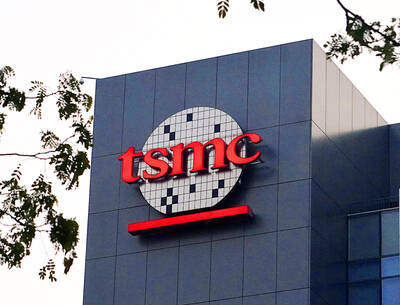Largan Precision Co (大立光) and Catcher Technology Co (可成) on Saturday reported rising revenue for last month from March, after most companies in the handset components sector reported weak first-quarter results amid the sluggish global smartphone market.
As leading suppliers in the global handset supply chain, the two companies’ revenue streams are closely monitored by market watchers to determine whether the smartphone market will follow expectations and show a recovery this quarter, or deteriorate faster than expected.
Handset camera lens maker Largan reported better-than-expected revenue for last month on the back of a continued improvement in yield rates and favorable product trends.
The Taichung-based company saw consolidated revenue reach NT$3.47 billion (US$116.8 million) last month, up 10.34 percent from the previous month.
Last month’s sales were still 6.02 percent lower than a year earlier, according to figures that Largan posted on its Web site on Saturday.
In the first four months of this year, consolidated revenue totaled NT$12.34 billion, down 14.84 percent from NT$14.5 billion during the same period last year.
The bright spot is that higher-priced lenses for cameras of 10 or more megapixels still made up a larger portion of shipments, accounting for 70 to 80 percent of the company’s overall shipments last month, while 8-megapixel products accounted for 10 to 20 percent and the 5-megapixel line contributed up to 10 percent, the company said.
Largan — whose customers include Apple Inc and several Android smartphone vendors — last month said it was upbeat about sales for this month and next month, compared with NT$3.14 billion in March, given the company’s efforts to improve production yield rates.
With potential strong demand for OLED iPhones in the second half of the year and the emerging adoption of triple-camera lenses by some handset vendors, as well as resilient prices and gross margin of the company’s products, Largan could see a year-on-year recovery in sales and operating profit from this month, Yuanta Securities Investment Consulting Co (元大投顧) analyst Jeff Pu (蒲得宇) said in a note on Wednesday last week.
Pu said Huawei Technologies Co (華為) is expected to drive triple-camera lens adoption by introducing a lower-spec device for the Mate 20 model, while Apple is likely to launch a new iPhone model with a triple-lens rear camera in the second half of next year.
Assuming that other vendors would follow suit and therefore boost adoption of the triple-lens design, it could “provide a much-needed improvement in Largan’s capacity utilization rate,” Pu said.
Meanwhile, casing maker Catcher posted revenue of NT$6.6 billion for last month, a surge of 1.3 percent from the previous month and up 28.54 percent from the same period a year earlier.
Cumulative revenue in the first four months totaled NT$27.01 billion, a 36.99 percent annual increase from NT$19.72 billion, the Tainan-based company said.
Catcher also released its audited first-quarter results, which showed that net profit increased 75 percent year-on-year to NT$3.66 billion, the company’s highest level for the same period, with earnings per share of NT$4.75.
However, gross margin declined to 41.75 percent and operating margin to 32.6 percent, both the lowest levels since the second quarter of 2016, company data showed.
Earnings per share in the first quarter came lower than KGI Securities Investment Advisory Co’s (凱基投顧) estimate of NT$5.27 and a market consensus forecast of NT$6.7.
Analysts said ahead of the data release that Catcher’s sales would be particularly strong in the second half of this year, closely aligned with customers’ scheduled launches of new products.
“The company’s sales in the first quarter were affected by weak iPhone demand and sales in the second quarter could be affected by the delayed launch of a new MacBook Air model,” KGI researchers led by Angela Hsiang (向子慧) said in a note on Monday last week.
KGI predicted that sales in the second half would be 65 percent higher than in the first half, and that profit in the second half would grow 124 percent from the previous half.
Overall, Catcher is likely to maintain its lead over metal casing peers in terms of profitability this year, thanks to its highly automated production lines and in-house development of cutters, tooling, fixture and feeder parts, which would allow the company to enjoy lower manufacturing costs, while having the capability to rapidly increase short-term production with a high yield and efficiency rate, KGI said.

CHIP RACE: Three years of overbroad export controls drove foreign competitors to pursue their own AI chips, and ‘cost US taxpayers billions of dollars,’ Nvidia said China has figured out the US strategy for allowing it to buy Nvidia Corp’s H200s and is rejecting the artificial intelligence (AI) chip in favor of domestically developed semiconductors, White House AI adviser David Sacks said, citing news reports. US President Donald Trump on Monday said that he would allow shipments of Nvidia’s H200 chips to China, part of an administration effort backed by Sacks to challenge Chinese tech champions such as Huawei Technologies Co (華為) by bringing US competition to their home market. On Friday, Sacks signaled that he was uncertain about whether that approach would work. “They’re rejecting our chips,” Sacks

Taiwan’s long-term economic competitiveness will hinge not only on national champions like Taiwan Semiconductor Manufacturing Co. (TSMC, 台積電) but also on the widespread adoption of artificial intelligence (AI) and other emerging technologies, a US-based scholar has said. At a lecture in Taipei on Tuesday, Jeffrey Ding, assistant professor of political science at the George Washington University and author of "Technology and the Rise of Great Powers," argued that historical experience shows that general-purpose technologies (GPTs) — such as electricity, computers and now AI — shape long-term economic advantages through their diffusion across the broader economy. "What really matters is not who pioneers

BUBBLE? Only a handful of companies are seeing rapid revenue growth and higher valuations, and it is not enough to call the AI trend a transformation, an analyst said Artificial intelligence (AI) is entering a more challenging phase next year as companies move beyond experimentation and begin demanding clear financial returns from a technology that has delivered big gains to only a small group of early adopters, PricewaterhouseCoopers (PwC) Taiwan said yesterday. Most organizations have been able to justify AI investments through cost recovery or modest efficiency gains, but few have achieved meaningful revenue growth or long-term competitive advantage, the consultancy said in its 2026 AI Business Predictions report. This growing performance gap is forcing executives to reconsider how AI is deployed across their organizations, it said. “Many companies

TAIWAN VALUE CHAIN: Foxtron is to fully own Luxgen following the transaction and it plans to launch a new electric model, the Foxtron Bria, in Taiwan next year Yulon Motor Co (裕隆汽車) yesterday said that its board of directors approved the disposal of its electric vehicle (EV) unit, Luxgen Motor Co (納智捷汽車), to Foxtron Vehicle Technologies Co (鴻華先進) for NT$787.6 million (US$24.98 million). Foxtron, a half-half joint venture between Yulon affiliate Hua-Chuang Automobile Information Technical Center Co (華創車電) and Hon Hai Precision Industry Co (鴻海精密), expects to wrap up the deal in the first quarter of next year. Foxtron would fully own Luxgen following the transaction, including five car distributing companies, outlets and all employees. The deal is subject to the approval of the Fair Trade Commission, Foxtron said. “Foxtron will be